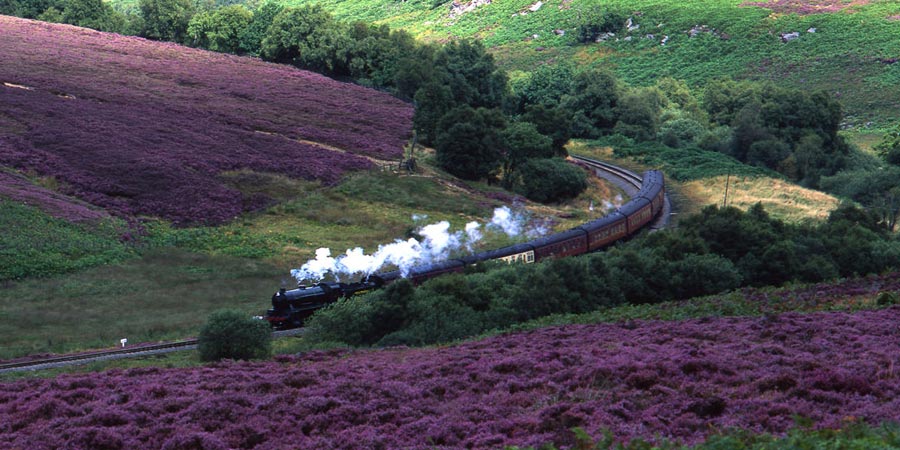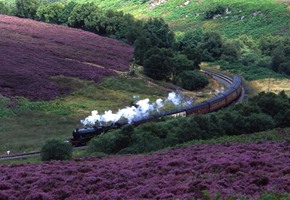There's something romantic about steam travel that goes beyond looking at the past through rose-tinted lenses. Maybe it's that whoosh of vapour as the engine lumbers up for departure or the slow, reassuring chug of the wheels as it pulls away, that distinctive high-pitched whistle piercing through busy cityscapes and empty fields alike.
Maybe, though, it's that they hark back to a time when the journey was as much a part of the excitement as the destination. It's easy to imagine, as you take in the intricacies of the locomotives, the wonder with which the Victorians beheld them as they climbed aboard - big metal monsters that ate coal at a rate of knots and travel at speeds never heard of before.
All that aside, it's just good fun to sit back and pretend you're in Downton Abbey (we recommend bringing a fancy hat, just to add to the experience) - and where better to do this than Yorkshire? God's Own Country boasts some of the best heritage railways in the UK, and some of the loveliest scenery to boot.
A match made in heaven? We certainly think so...
The Keighley and Worth Valley Steam Railway through Brontë Country
If you want to experience Yorkshire at its finest, a relaxed rail ride through the Pennines is just the ticket (see what we did there?).
Originally constructed in 1867 by the wealthy mill owners of the area, the Keighley and Worth Valley Steam Railway runs through the Worth Valley to Oxenhope. The line features original rolling stock from the early 20th century, all of which has been beautifully restored - rail enthusiasts can check out the history of each of the line's locomotives on their website.
The railway is an attraction in itself - film and TV buffs may recognise it from a number of screen appearances, most notably the 197X film The Railway Children, and you'll get an informative guided tour on board.
Still, there's one stop along the route that we feel is unmissable:
Haworth and the Brontës
If you'd like to immerse yourself in Yorkshire's considerable literary history, Haworth is a must-visit on this particular line.
Birthplace of the Brontës, this picturesque village has changed little since the middle decades of the 19th century, when the sisters were writing their famous novels. Literary aficionados will love the Brontë Parsonage Museum, which is housed in the original family home and boasts a range of their personal possessions, as well as an exhibit on how they lived and worked.
If you fancy a wander, take a walk from the village to up to the waterfalls of Top Withens - the inspiration for Wuthering Heights. On the way, you'll cross Brontë Bridge, which is said to have been one of the sisters' favourite places.
Whitby, via the North York Moors Railway
North Yorkshire sits at a unique cross-section between rugged and refined. Elegant sandstone towns dot the otherwise wild and windswept hills - the perfect setting to enjoy an atmospheric rail journey right through the centre of the North York Moors National Park.
The history of the North York Moors Railway goes right back to the dawn of rail travel, when in 1833 the Whitby and Pickering Rail Company gained permission to construct a horse-powered railway between the two towns. It was thought that better land access - previously difficult due to the treacherous Moorland terrain - would revive Whitby's fortunes as a fishing port and industrial centre.
It was from these humble origins that the railway grew, and though there have been various iterations of it as the UK's rail network developed, the views over the Moors remain as breathtaking as ever. Added bonus - the railway was used as a filming location for Downton Abbey, so you can live out those period drama dreams we touched on above.
Incorporating this gem of a heritage railway into a trip to the seaside is a fantastic way to experience some of Yorkshire's finest charms. Whitby really is a seaside town like no other - so as well as the pleasant promenades and first-class fish and chip options, be sure to take in:
Whitby Abbey
Another of the county's famous literary sights, the Gothic arches of Whitby Abbey loom forebodingly on the cliff tops above the town. The Abbey was the inspiration for Bram Stoker's famous 19th-century horror novel, Dracula, and is a big draw for the many Goths that visit the city.
It's as impressive seen from up close as it is from a distance and for a modest entrance fee, visitors can take a tour and learn more about how it inspired Stoker, as well as Whitby's importance as an ecclesiastical centre throughout the middle ages.
The Old Town
In need of some retail therapy, or perhaps just a wander round a picturesque harbour? Whitby's Old Town delivers on both these fronts. Expect quirky independent shops and cosy cafes, sprawling over labyrinthine medieval streets, and there's also a rather lovely walk out from here to the old lighthouse, if you need to stretch your legs.
If you're looking for a suitably Gothic souvenir of your trip, the Old Town is a great place to search for Whitby jet jewellery - the town is famous for the black gemstone, and local craftspeople set it into everything from elegant pendants to heavy, Gothic chokers. Alternatively, go beachcombing and try to find some yourself!





